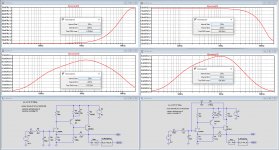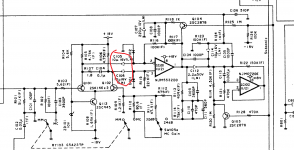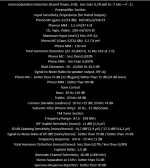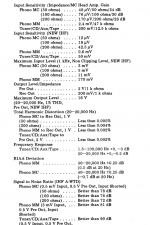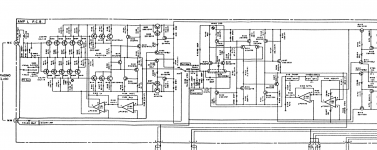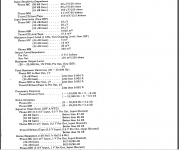Always happy to review things with LTSpice, I took the circuit diagram that Marcel showed.
Unfortunately I could not find a model for this Fet that has a very high ca. 14nV/rtHz at 1Khz.
That's why I used a 6nV/rtHz Fet, the LS5905.
One version with a 47K at the input and the other with a 4.7M driven from a point that's -99 times the input signal, thereby simulating a 47K input load.
I have simulated both flat in the two upper images and Riaa processed and A-weighted in the two middle images.
Flat gave resp: 3.25uV and 0.86uV from 20Hz to 20Khz, a bonus of 11.5dB for the "cooled"version.
However for a Riaa preamp, flat noise figures without Riaa do not give a proper indication for perceived noise.
That's why I also measured the Riaa processed and A-weighted noise, that came out as resp 675nV and 435nV, which is an improvement of 3.8dB for the cooled version, still nice but quite a bit different from the earlier 11.5dB.
Hans
Unfortunately I could not find a model for this Fet that has a very high ca. 14nV/rtHz at 1Khz.
That's why I used a 6nV/rtHz Fet, the LS5905.
One version with a 47K at the input and the other with a 4.7M driven from a point that's -99 times the input signal, thereby simulating a 47K input load.
I have simulated both flat in the two upper images and Riaa processed and A-weighted in the two middle images.
Flat gave resp: 3.25uV and 0.86uV from 20Hz to 20Khz, a bonus of 11.5dB for the "cooled"version.
However for a Riaa preamp, flat noise figures without Riaa do not give a proper indication for perceived noise.
That's why I also measured the Riaa processed and A-weighted noise, that came out as resp 675nV and 435nV, which is an improvement of 3.8dB for the cooled version, still nice but quite a bit different from the earlier 11.5dB.
Hans
Attachments
Cassette decks without dolby sat around 58db S/N. Vinyl always sounded 15 -20 db better then that. Vinyl does not have the high frequency electronic hiss that tape has.
I tend to favor jfet input MM gain cells because of the simplicity of bias - with less stuff hanging off the input, there is less opportunity for pickup. I've also been playing with hybrid tube-solid state gain cells due to the nature of the tube capacitance vs. solid state. It's a linear capacitance of metal elements spaced in a vacuum rather than a voltage-variable capacitance like in transistors and fets. Of course, I cascode the input element, but due to the nature of the gain cell, that may not be necessary, as the gain of the input stage is a little bit less than unity in simulation....
However, for finnicky fets like the LSK/2SK170, you want that cascode to reduce the D-S voltage to tame the otherwise high bias current, as the voltage knee for transition to highly nonlinear leakage current is pretty low for these fets.
Noise has not been a major concern for me, as long as I can't hear it... I also use jfets because of the low input bias current, as I have been burned by bipolar circuits and high inductance cartridges in the past.
I've been using simple (3-4 active devices) single-ended gain cells similar to the Hoeffelman and Meys that simulate well in terms of distortion. I have a submini vacuum tube - solid state hybrid preamp waiting for me to to take the time to quiet down the DC-DC converter that's driving it. It's a surprisingly compact board that incorporates 2 channels of RIAA preamp + line amp. It's small enough that I could contemplate putting an active crossover in the same case (a repurposed HP enclosure, classic olive plastic +aluminum).
However, for finnicky fets like the LSK/2SK170, you want that cascode to reduce the D-S voltage to tame the otherwise high bias current, as the voltage knee for transition to highly nonlinear leakage current is pretty low for these fets.
Noise has not been a major concern for me, as long as I can't hear it... I also use jfets because of the low input bias current, as I have been burned by bipolar circuits and high inductance cartridges in the past.
I've been using simple (3-4 active devices) single-ended gain cells similar to the Hoeffelman and Meys that simulate well in terms of distortion. I have a submini vacuum tube - solid state hybrid preamp waiting for me to to take the time to quiet down the DC-DC converter that's driving it. It's a surprisingly compact board that incorporates 2 channels of RIAA preamp + line amp. It's small enough that I could contemplate putting an active crossover in the same case (a repurposed HP enclosure, classic olive plastic +aluminum).
That's why I also measured the Riaa processed and A-weighted noise, that came out as resp 675nV and 435nV, which is an improvement of 3.8dB for the cooled version, still nice but quite a bit different from the earlier 11.5dB.
Hans
It will drop further when you use a cartridge model with frequency-dependent ESR. I once estimated a 3 dB best-case improvement for a Shure V15-III cartridge; that would be the RIAA- and A-weighted improvement when there is no record playing and the thermal noise from the cartridge and from the 47 kohm were the only noise sources. That is, the 47 kohm gave about as much RIAA- and A-weighted thermal noise as the cartridge.
I
Noise has not been a major concern for me, as long as I can't hear it... I also use jfets because of the low input bias current, as I have been burned by bipolar circuits and high inductance cartridges in the past.
QUOTE]
I’m glad to see that you brought up the input bias current issue with BJT inputs. This has been talked about Walt Jung and Marshall Leach as the current can negatively affect the phono cartridge. Some BJT input designs use a cap on the input to couple to the cartridge to isolate the bias current. When using a JFET or tube as a input stage we do not have to be concerned with the bias current, and both will be less affected by RFI that a BJT input.
In the 1977 Marshal Leach published an article in Audio magazine on a low noise preamp that used a bJT input and later modified the design to use a fet input. He sold these preamps as a kit or assembled and I bought both preamps. I can't recall that I noticed any difference in the noise. Then I had a Shure V15-4 cartridge.
http://leachlegacy.ece.gatech.edu/papers/wbpreamp/feb77article.pdf
http://leachlegacy.ece.gatech.edu/papers/wbpreamp/feb77article.pdf
"cooling" with negative feedback works very well. Just got an AT-VM95e cart that I am going to make a flat front end stage for. I am expecting MC cart flatness and response.
It will drop further when you use a cartridge model with frequency-dependent ESR. I once estimated a 3 dB best-case improvement for a Shure V15-III cartridge; that would be the RIAA- and A-weighted improvement when there is no record playing and the thermal noise from the cartridge and from the 47 kohm were the only noise sources. That is, the 47 kohm gave about as much RIAA- and A-weighted thermal noise as the cartridge.
Yes of course, it is highly dependent on the Cart used.
When I change the Orto 2M blue for a Shure V15-III, gain from this circuit over a non cooled version drops to 2.6dB.
But at the end, it is mostly an intellectual challenge that is not needed at all, unless a much lower termination as the 47K is used.
In that case it will enable to recover the caused losses if necessary.
Hans
Could you explain that? I know that a capacitor at the self resonant frequency has an ESR and ESL and that an inductor at the self resonant frequency has an equivalent parallel resistance and capacitance. How do you get ESR for an inductor?It will drop further when you use a cartridge model with frequency-dependent ESR.
I mean the real part of the impedance. That is, superconducting coils excepted, any real-life inductor has losses (when you try to store power in it, it will gradually get dissipated) and no matter where they come from physically, you can mathematically represent those losses with a series resistance or with a parallel resistance, albeit usually a frequency-dependent resistance.
The point I was trying to make is that real-life cartridges normally have more losses than just the ohmic resistance of the wire of the coil, and all those losses have thermal noise associated with them.
The point I was trying to make is that real-life cartridges normally have more losses than just the ohmic resistance of the wire of the coil, and all those losses have thermal noise associated with them.
... an inductor at the self resonant frequency has an equivalent parallel resistance and capacitance. How do you get ESR for an inductor?
Think "copper resistance".
Every coil has some.
Yes, near resonance we can flip series resistance around reactance and get a parallel resistance. We also have physical parallel resistance. But in most coils, in most uses, the physical series resistance often dominates.
Another way to look at this is the 47k load resistor is shunted by the series combo of the cart resistance plus its L. At LF the preamp sees the cart R in parallel with 47 k load R. As frequency increases, the L increases and the total source seen by the preamp increases so at 20 kHz, it can be 10-15k Ohms. You have three noise components: noise voltage of the amplifier, noise current x source resistance and finally thermal noise contribution of the resistive part of the cart. All these sources add up RMS style for the total equivalent input noise.
With a JFET input pre, there is almost zero noise current, only noise voltage, unlike bipolar where the noise current can be quite high. So the noise current x the total source resistance part effectively is not there and this is why JFET input stages make good MM phono preamps provided the noise voltage is low - there are some very good devices in this regard like BF862 (discontinued now) and LSK389
With a JFET input pre, there is almost zero noise current, only noise voltage, unlike bipolar where the noise current can be quite high. So the noise current x the total source resistance part effectively is not there and this is why JFET input stages make good MM phono preamps provided the noise voltage is low - there are some very good devices in this regard like BF862 (discontinued now) and LSK389
We still have a lot to learn from the real masters when it comes to properly using fet input phono preamps, don't you think so?
Input shorted and ‘A’ weighted is not the way to test a phono preamp - and especially MM. A modern MM phono pre with the input shorted and ‘A’ weighted is about 10 dB better.
You absolutely cannot judge a phono pre’s performance with the input shorted and especially on MM.
The only sensible reason to do this (which I do ) is to look for mains noise components which with a cart connected would be buried below the noise floor on the decent design.
These old Japanese amps were great products, but we can do better today.
🙂
It's such a pity that you didn't apply for a design role at Nakamichi in the 80's...They might have been way better than they were with you on board, perhaps being able to apply to Intergalactic Patents too!
Last edited:
These old Japanese amps were great products, but we can do better today.
🙂
Much better in some cases. Particularly around optimal loading of the cartridges. Interestingly if you can get capacitance low enough a number of cartridges are happy loaded at 80-100k. Makes implementation unusual but where's the fun in following the crowd?
Are you envious on preamps that sell for less than 500 dollars?
Ok...you two...or maybe three or four of you later will never need to learn anything from Nakamichi ...
Apparently "Le mieux est l'ennemi de bien, mais le pire est l'ami de l'exces!"
By the way...this one is made by the same guy in the late 80's too, the same with the others...apparently someone else stole your job:
http://toon-global.sblo.jp/article/186002670.html
https://audiokarma.org/forums/index.php?threads/nakamichi-ca-5-preamp-killer-phono-section.605604/
https://www.diyaudio.com/forums/analogue-source/272882-pre-nakamichi-ca5.html#post4292800 same feedback network, same 3n172... poor Nelson... he didn't know that two other guys will crush his design skils 30 years later...
Ok...you two...or maybe three or four of you later will never need to learn anything from Nakamichi ...
Apparently "Le mieux est l'ennemi de bien, mais le pire est l'ami de l'exces!"
By the way...this one is made by the same guy in the late 80's too, the same with the others...apparently someone else stole your job:
http://toon-global.sblo.jp/article/186002670.html
https://audiokarma.org/forums/index.php?threads/nakamichi-ca-5-preamp-killer-phono-section.605604/
https://www.diyaudio.com/forums/analogue-source/272882-pre-nakamichi-ca5.html#post4292800 same feedback network, same 3n172... poor Nelson... he didn't know that two other guys will crush his design skils 30 years later...
Attachments
Last edited:
- Status
- Not open for further replies.
- Home
- Source & Line
- Analogue Source
- FET vs BJT input phono preamp
